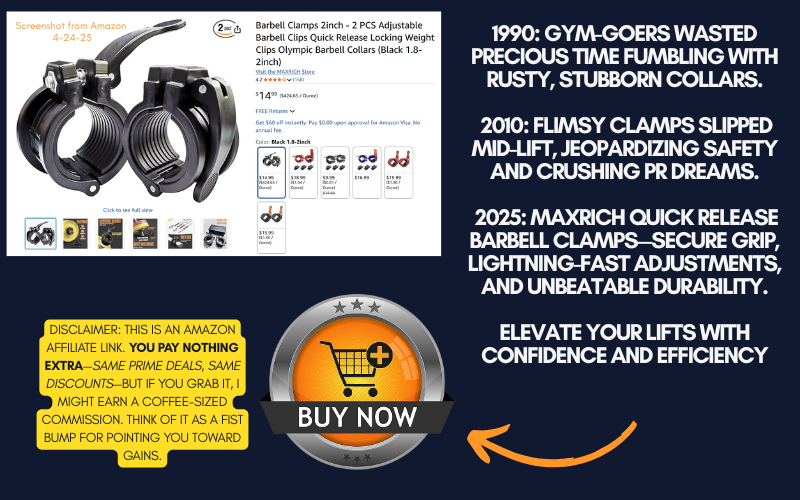Barbell collars aren’t the flashiest piece of gym gear—but they’re the silent guardians of every rep you own. Let’s cut through the noise: If your plates wobble, your focus fractures. If your collar fails, your PR becomes a hazard. So, are the MAXRICH Quick Release Barbell Clamps (2-inch) worth strapping onto your barbell? Let’s dissect exactly who wins with these—and who should walk away.
The Science of Securing Gains
Barbell collars aren’t just “clips.” They’re physics in motion. Loose plates shift momentum, stealing power from your lift and increasing injury risk. The MAXRICH clamps? Steel jaws with a 2-inch grip, adjustable for barbells with sleeve diameters from 1.8” to 2”. Translation: They bite down harder than your pre-workout espresso.
“Collars aren’t optional—they’re insurance,” says Eugene Thong, CSCS. “A slipping plate isn’t just annoying; it’s a torn ligament waiting to happen.”
Who These Clamps Are For (And Who Should Skip Them)
✅ WORTH IT IF YOU:
- Lift heavy, ugly, and often (powerlifters, CrossFitters, garage warriors).
- Hate finicky spring collars that pretend to lock.
- Need gear that survives chalk, sweat, and your gym bag’s dark abyss.
❌ NOT WORTH IT IF YOU:
- Lift occasionally with toy weights (these are overkill for 10lb curls).
- Prefer “quick” collars that require a PhD to operate.
- Want flashy colors to match your neon lifting shoes.

MAXRICH Quick Release Clamps: Brutal Pros & Unfiltered Cons
| Pros | Cons |
|---|---|
| Top-notch steel (no bend, no BS) | Not for barbells under 1.8” sleeves |
| 5-second release (no tools, no fuss) | Minimalist design (no “ego” branding) |
| Fits most bars (Olympic, powerlifting) | 30-day returns (but we bet you’ll keep ‘em) |
“But Do I Really Need Collars?”
Let’s get primal: Your lifts are only as strong as your weakest link. Spring collars crack. Zip ties snap. The MAXRICH clamps? They’re the carnivore of collars—simple, relentless, and built to outlive your gym membership.
“Collars protect more than plates; they guard your confidence,” adds Charles Damiano, B.S. Clinical Nutrition. “When the weights stay put, you stay in the zone.”
Ready to lock in your lifts? Secure Your Set Here. Quick note: These are Amazon affiliate links—you don’t pay a penny more, still snag all discounts, and you’ll help support our work (we may earn a small commission). Think of it as a fist bump for pointing you toward clean gains.
Q&A: Uncommon But Relevant
A: Steel collars add marginal weight—about 0.2lbs each. For 99% of lifters, this won’t tip the scales. But competitive powerlifters chasing record-level precision might notice (or overthink) the difference. “It’s psychological inertia,” says Eugene Thong. “Your brain registers ‘secure,’ not ‘grams.’”
A: If you’re slapping straps on a loaded bar, the 2-inch profile could crowd your grip. Solution? Load plates inward, leaving 1-2 inches of sleeve exposed. “It’s like parking a truck—give yourself space to maneuver,” advises Charles Damiano.
A: Steel-on-steel friction can leave micro-scratches, but it’s cosmetic—not structural. If your bar’s chrome or cerakote finish is your pride, rotate collar positions occasionally. Pro tip: Wipe sleeves clean post-lift to grind less grit into the metal.
A: Rare, but yes. Strongman trainees practicing “rolling” log cleans or axle bar work sometimes ditch collars to let plates shift intentionally—a niche technique to mimic competition chaos. For everyone else? Keep ‘em clamped.
A: The adjustable tension combats tilt, but physics always wins. If you’re loading 400lbs on one sleeve and 5lbs on the other, even steel jaws will protest. “Collars aren’t miracles,” says Thong. “They’re force multipliers—not force negators.”
A: High-carbon steel resists rust, but salt air is the Terminator of corrosion. Monthly wipe-downs with a dry cloth and occasional silicone spray keep the mechanism smooth. “Neglect is the real enemy,” says Damiano. “Treat them like your joints—maintain or pay the price.”
YOUR NEXT STEPS:
The MAXRICH clamps aren’t here to convince you. They’re here to do a job—one that lets you stop worrying about sliding plates and start channeling your inner beast. If that’s your style, grab ‘em. If not? Well, good luck explaining those uneven deadlifts.

